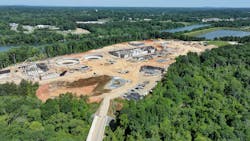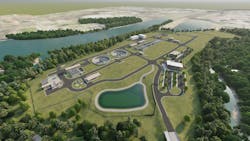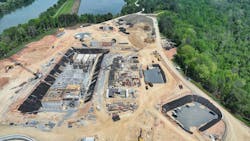This is the largest project in Charlotte Water's history
Charlotte Water is in the process of building the largest project in its history to meet the future wastewater treatment needs of one of the fastest growing regions in the country.
Population growth drives advancement
The new Stowe Regional Water Resource Recovery Facility (Stowe RWRRF) is a state-of-the-art wastewater treatment plant that will serve northwestern Mecklenburg County and eastern Gaston County in North Carolina. Based on the belief that our water and wastewater resources are best managed regionally, Charlotte Water, the City of Mount Holly and the City of Belmont formed a partnership in 2006 to ensure that their communities possessed the necessary infrastructure and treatment capacity to accommodate future wastewater flow projections.
“Wastewater management is a critical aspect of community infrastructure,” Director of Charlotte Water Angela Charles said. “By expanding our capacity to treat wastewater effectively, we can unlock tremendous potential for growth, economic development and environmental sustainability.”
For more than a decade, Charlotte has maintained a place in lists of the top ten fastest growing metropolitan areas in the country. Its population is projected to expand another 50% by 2050. Within Stowe RWRRF’s service area alone, the population is expected to increase by 58% from 104,199 residents in 2024 to 177,166 residents in 2034.
Initially, Stowe RWRRF will have the capacity to process and treat up to 15 million gallons of wastewater per day when it opens in 2027. Stowe RWRRF will be built with the expectation that it will be able to process up to 25 million gallons of wastewater per day in the future as the region continues to experience burgeoning growth.
Replacing aging infrastructure
Another crucial driver for this project were two aging municipal wastewater treatment plants in the cities of Belmont and Mount Holly, with both being located on the opposite side of the Catawba River from Charlotte. If the existing Belmont and Mount Holly Wastewater Treatment Plants were to remain in use, each facility would need to undergo extensive and expensive upgrades to increase capacity and meet stringent environmental regulations.
Instead, these plants now will be replaced with pumping stations that send their respective wastewater to Stowe RWRRF through new force mains installed deep underneath waterways using a technique known as horizontal directional drilling (HDD). The HDD process involved drilling a pilot hole and subsequent reaming passes (to make the hole larger) through the underground bedrock to form a pathway that the force mains were then pulled through. This bore is 3,100 LF long and located roughly 75 feet under the bottom of the Catawba River and Long Creek. The force main material is High Density Polyethylene (HDPE), which is fused together and therefore has no joints for leaks to occur.
Utilizing new technology
Another key and exciting aspect of Stowe RWRRF will be its implementation of the latest technologies and cutting-edge treatment techniques to more effectively clean and purify wastewater. It will achieve this goal through embracing a modern densified activated sludge (DAS) biological nutrient removal (BNR) process to decrease nutrient — primarily nitrogen and phosphorus — discharges into the Catawba River. DAS intensifies, or optimizes, the BNR process by accelerating the settling and compaction of activated sludge. Research indicates that the improved settling observed in DAS is linked to the greater proportion of large particles, called granules, versus smaller particles, known as flocs, compared to conventional activated sludge (CAS) systems.
Improved sludge settleability allows operation at increased mixed liquor suspended solids (MLSS) concentrations and secondary clarifier solids loading rates, which reduces required aeration basin volume and infrastructure costs. Projected infrastructure savings associated with improved settling through DAS is expected to reduce future costs by more than $20 million when Stowe RWRRF begins processing 25 million gallons of water daily.
DAS is accomplished at Stowe RWRRF by providing both biological and physical selective pressures. Biological selection for well-settling solids is achieved through multi-zone anaerobic and anoxic zones, which provide for a high Food:Mass (F:M) gradient and allow rapid uptake of readily biodegradable carbon under “feast” conditions. Physical selection is provided through surface wasting (SWAS) and subsurface wasting using telescoping valves under quiescent conditions such as density wasting (DWAS).
Beyond implementing DAS, Stowe RWRRF will also include flexible BNR basins to allow operation in multiple process configurations with baseline operation as part of a five-stage BNR process. Features of the BNR basins will include:
- Selector zones that can be operated as traditional anaerobic zones or as RAS or mixed liquor (ML) fermentation zones to promote side stream enhanced biological phosphorus removal (S2EBPR).
- Pre-anoxic zones that provide for denitrification by utilizing influent biodegradable carbon.
- Swing zones that can operate at pre-anoxic or aerobic volume.
- Aerobic zones to reduce biodegradable carbon, oxidize ammonia into nitrate and provide for phosphorus uptake.
- Deoxygenation zones to reduce dissolved oxygen (DO) to the post-anoxic zones, and in the nitrified recycle (NRCY), to the pre-anoxic zones.
- Post-anoxic zones to further reduce effluent total nitrogen (TN). Endogenous, meaning generated from decay or the lysis of biomass, and internally stored carbon can be supplemented by an external carbon addition to increase TN reduction.
- Reaeration zones to oxidize any residual ammonia and biodegradable carbon prior to the final clarifiers.
The design will also allow for advanced process controls, including ammonia-based aeration control (ABAC), nitrate-based NRCY and supplemental carbon feed control, orthophosphate-based chemical phosphorus removal and real-time solids retention time (SRT) monitoring to calculate optimal wasting rate. These advanced controls will reduce energy and chemical usage while meeting strict effluent nutrient requirements.
For example, high-speed, gearless turbo blowers using magnetic bearings will provide processed air to the BNR basins. Turbo blower technologies offer best-in-class efficiency while minimizing maintenance. Variable pressure-based blower control utilizing most open valve (MOV) control furthermore will reduce the energy associated with blower operation.
Maintaining clean waterways
Perhaps most importantly, Stowe RWRRF’s enhanced cleaning technology will achieve near drinking quality water levels for the water that is released back into the Catawba River. This will have a beneficial impact on the growing ecotourism industry in the area, including boating, rafting and kayaking, allowing the public to benefit from scenic natural surroundings while pursuing water sports.
This regional collaboration between Charlotte Water, Belmont and Mount Holly not only provides more cost-effective and environmentally conscious wastewater management services but also fosters a more resilient and sustainable region. It allows Charlotte Water to optimize the use of its water resources, particularly the pristine Catawba River that borders its communities.
Conclusion
Charlotte Water is deeply committed to advancing sustainability and preserving the natural environment while working on this project. The facility will greatly reduce the 27-mile route it previously took to pump wastewater from North Charlotte to Pineville, cutting down on energy consumption and reducing the risk of wastewater spills.
Moreover, Charlotte Water decided to conserve much of the 90 acres of natural land surrounding Stowe RWRRF as part of a Community Benefit Project. The project will include an educational walking trail, public meeting space, collaborative partnership with the Catawba Lands Conservancy and educational partnerships with nearby schools.
Construction began on Stowe RWRRF in 2020, and the plant is expected to be fully operational in 2027. For more information about the project, visit stoweregionalwrrf.com
About the Author

Nicole Bartlett
Nicole Bartlett is a Division Manager within the Engineering Division at Charlotte Water, a department of the City of Charlotte. She is serving as the Project Manager for the Stowe RWRRF program. Bartlett has 17 years of experience in the water and wastewater industries and has served in regulatory, consulting and owner roles. She has managed both collaborative and traditional delivery projects of more than $500 million.

Will Shull
Will Shull is an Associate Vice President with HDR in the Charlotte office and serves as the Owner Advisor for Charlotte Water on the Stowe Program of projects. HDR is headquartered in Omaha, Neb. During his 12 years at HDR, Shull has primarily been engaged in collaborative delivery projects in water and wastewater treatment facilities. He currently serves as a Vice Chair of the new professional committee for the Water Collaborative Delivery Association.

Joe Rohrbacher
Joe Rohrbacher is a Vice President in Hazen and Sawyer’s Charleston, S.C. office and has 25 years of experience primarily in the evaluation and design of water resource recovery facilities. He serves as the secondary process design lead for Stowe RWRRF. He has worked on more than 90 projects involving the evaluation, optimization or detailed design of biological nutrient removal systems.



